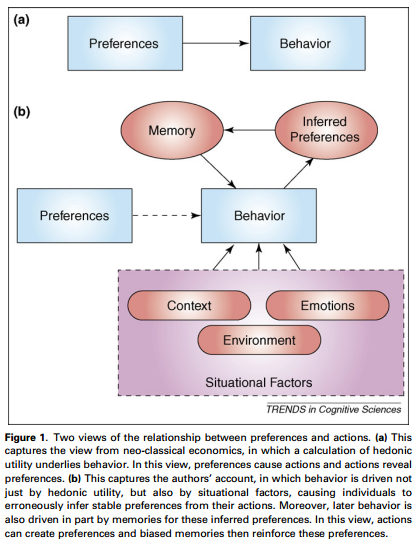
Understanding Consumer Preferences with Neuroeconomics
Filed Under: Data Trends, Shopper

Margot Tuchler
We know how important understanding the shopper experience is when it comes to grasping, predicting, and thus capitalizing on consumer behaviors. Our ShopperEyes® division is dedicated to deepening our knowledge of just what drives purchase decisions.
Dan Ariely, a professor of Psychology and Behavioral Economics at Duke University, and Michael Norton, a Harvard business professor and member of Harvard’s Behavioral Insights Group, wrote about the relationship between preference and action, which is not as one-sided as we may be inclined to believe. Not surprising is that Ariely and Norton describe how completely arbitrary environmental factors can influence a decision. What’s interesting is that people can misinterpret those arbitrary situational factors as their preferences, or their beliefs in a thing’s “hedonic utility,” and thus their preferences for something are cemented permanently – based on something completely arbitrary. Here’s specifically what they have to say:
“The neo-classical economics view that behavior is driven by – and reflective of – hedonic utility is challenged by psychologists’ demonstrations of cases in which actions do not merely reveal preferences but rather create them. In this view, preferences are frequently constructed in the moment and are susceptible to fleeting situational factors; problematically, individuals are insensitive to the impact of such factors on their behavior, misattributing utility caused by these irrelevant factors to stable underlying preferences.”
They give a few examples to help illustrate this idea. One is likely familiar – when prospective students visit a college campus on a day with nice weather, they’re more likely to choose to attend that college than if they visited on a day with rainy weather. Of course, students wouldn’t say they picked the school based on the weather – they’re unaware of the environmental factor that actually influenced their decision.
Another example Ariely and Norton provide is a bit more relevant to shopper behavior and thus shopper research:

“In one experiment, participants were asked to indicate whether they would pay a given price – arbitrarily set by the last two digits of their social security number – for a range of products, after which they bid for those items in an auction. Despite the arbitrary nature of these price anchors (the utility of a bottle of wine likely has little to do with one’s social security number), people with higher social security numbers bid more for bottles of wine… Those participants whose values for bottles of wine had been set arbitrarily by their social security numbers, for example, made bids for subsequent bottles of wine that followed in a coherent manner, such that better bottles of wine fetched higher prices, and inferior bottles lower prices.”
So, absolutely arbitrary factors can have a lasting, if not permanent, impact on how consumers perceive their own preferences and, consequently, their purchase decisions. This speaks to the value that shopper research methodologies, particularly when done in- context, can have. For example, in person and virtual shopalongs can be used as tools that help us to look for patterns of environmental factors at play, and also serves as a reminder to consider consumers’ self-professed motivators within the context of their situation or environment.
Ariely and Norton also note how neuroeconomics can make it possible to pinpoint the effect and influence different factors have on consumers’ preferences and, as a result, their decisions. The potential for neuroeconomics as a market research tool is not new knowledge, but this research sheds light on yet another way in which it could be deployed to cultivate actionable insights and potentially bolster the tried and true methods we continue to use.
explore featured
Case studies
